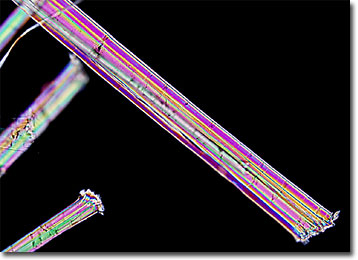Polarized Light Microscopy Digital Image Gallery
Hemp Fibers
As many as ten thousand years ago, hemp, which is the strongest natural fiber in the world, was considered a staple of civilization. In fact, early American colonists were required by law to grow hemp, and, even more recently, during World War II, the United States government subsidized its production for military use.

The most useful and valuable hemp fiber is derived from the plant scientifically described as Cannabis sativa. Cloth made from the fiber of this plant is extremely strong, durable, and resistant to mildew. It is also cheaper to produce than cotton cloth, and crops of Cannabis plants grow well without herbicides, fungicides, or pesticides. Due to its many advantages over other natural fibers, hemp has been utilized to create a wide variety of products over the course of history, including clothing, paper, rope, and netting. Indeed, hemp was the material utilized to fabricate the earliest Levi Strauss blue jeans and samples of hemp-based paper have been found that date back at least 1500 years.
Over the last several decades, the popularity of hemp fiber items has decreased considerably in the United States. The primary reason for this drop off in hemp usage is due to the relation between the fiber and the drug marijuana. Since both items can be derived from the same plant, the laws regulating the growth and possession of Cannabis are complicated. Basically, however, the flowers, buds, and leaves of the plant are considered marijuana and are illegal to possess, but the roots, stems, and stalks are classified as hemp and are not under regulation. Yet, since it is impossible to grow hemp without being in possession of marijuana, all hemp production in the United States has ceased. Thus, any hemp products that are utilized in the country must be imported from other nations.
